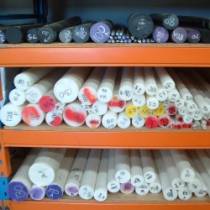Cutting Acrylic Plastic Sheet
How to Cut Acrylic Sheet with a Knife or Scriber
 Acrylic sheet up to 3/16″ thick may be cut by a method similar to that used to cut glass. Use a scribing knife, a metal scriber, an awl, or a utility knife to score the sheet. Draw the scriber several times (7 or 8 times for a 3/16″ sheet) along a straight edge held firmly in place. Then clamp the sheet or hold it rigidly under a straight edge with the scribe mark hanging just over the edge of a table. Apply a sharp downward pressure to break the sheet along the scribe line. Scrape the edges to smooth any sharp corners. This method is not recommended for long breaks or thick material.
Acrylic sheet up to 3/16″ thick may be cut by a method similar to that used to cut glass. Use a scribing knife, a metal scriber, an awl, or a utility knife to score the sheet. Draw the scriber several times (7 or 8 times for a 3/16″ sheet) along a straight edge held firmly in place. Then clamp the sheet or hold it rigidly under a straight edge with the scribe mark hanging just over the edge of a table. Apply a sharp downward pressure to break the sheet along the scribe line. Scrape the edges to smooth any sharp corners. This method is not recommended for long breaks or thick material.
Cutting Perspex with Power Saws
Special blades are available to cut acrylic. Otherwise use blades designed to cut aluminum or copper. Teeth should be fine, of the same height, evenly spaced, with little or no set.
Cutting Acrylic Sheet with Table and Circular Saws
Use hollow ground high speed blades with no set and at least 5 teeth per inch. Carbide tipped blades with a triple chip tooth will give the smoothest cuts. Set the blade height about 1/8″ above the height of the material. This will reduce edge chipping.
When using a hand held circular saw, clamp the sheet to the work surface and use a length of 1×3 wood to distribute the clamping pressure and act as a guide for the saw.
Feed the work slowly and smoothly. Lubricate the blade with soap or beeswax to minimize gumming from the masking adhesive. Be sure the saw is up to full speed before beginning the cut. Water cooling the blade is suggested for thicknesses over 1/4″, especially if edge cementing will be performed.
Cutting with Saber Saws
Use metal or plastic cutting blades. The blades you use to cut acrylic should never be used for any other material. Cut at high speed and be sure the saw is at full speed before beginning the cut.
How to Cut Perspex Without Cracking with Hand Saws
Good results are possible, but very difficult. Be sure the acrylic is clamped to prevent flexing. Flexing at the cut may cause cracking.
Routers and shapers
Use single fluted bits for inside circle routing and double fluted bits for edge routing. At the high speeds at which routers operate it is critical to avoid all vibration. Even small vibrations can cause crazing and fractures during routing.

